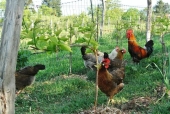I come from another grow world, medical marijuana, and have done it for many years (its legal where I am). I am very well versed on grow science, organics, plant health, integrated pest management. However, I am used to a monoculture. Permaculture is all new to me, and I am here to soak up what I can. I have grown tomatoes successfully and unsuccessfully. I have grown potatoes successfully until they were ravaged by deer. I do have chickens (egg-laying only) and have done quite well with them, despite coyotes trying to munch on them. I have been composting here for a few years now and I suspect that I have a rather diverse and rich
compost. I have grown plants amended with my own chicken manure and they are very healthy, I've also added some local earth for the mineral content. I have some excellent peach trees and apple trees on my property, and I have tried to plant nectarine and apricot, but I think the deer already chewed up the trunks pretty bad.
I live in an arid part of northern Colorado. My water here is very high in sodium carbonate and bicarbonate. The soil, or dirt, is very sodic and alkaline. From what I have read, there is really only 2 ways to lower the soil pH, sulfur or peat. Any opinions or ideas on that? I have around 20 acres on a hillside available to me. It is ranch land, perfect for running cows, but nothing grows here except hardy shrubs and sparse grasses. My climate hardiness zone is 5a and 100+mph winds are common, in spring and fall especially. On a regular basis, elk, deer, mountain lions, bobcats, coyotes, stray dogs, drunk hippies, rabbits, and many other wildlife will do what they will to anything growing on or around my land. How do I maintain my top soil? Where and how do I start building up my soil? I don't have much of a budget, and I don't know a lot of people that I can get to work for free. But my wife and I really want to do more. I have a good bit of hurdles to overcome. I'd like to start small, maybe work on 1-2 acres and expand from there.
I've ID'd on this very rocky and sandy piece of land wild growing prickly pear, mullein, dandelion, and mustard. I can't say I'm a nature expert and have never had any formal learning on what certain shrubs, trees, or anything really is. My background is energy science and computers. I want to learn as much and grow and be able to identify plants much better.






